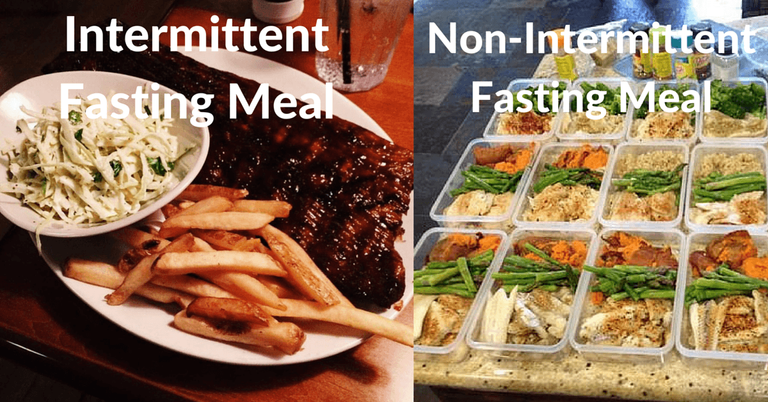Intermittent fasting is a term for an eating pattern that cycles between periods of fasting and eating.
It does not say anything about which foods you should eat, but rather when you should eat them.
In this respect, it is not a “diet” in the conventional sense. It is more accurately described as an “eating pattern.”
Common intermittent fasting methods involve daily 16 hour fasts, or fasting for 24 hours, twice per week.
Humans have actually been fasting throughout evolution. Sometimes it was done because food was not available, and it has also been a part of major religions, including Islam, Christianity and Buddhism.
When you think about it, our hunter-gatherer ancestors didn’t have supermarkets, refrigerators or food available year-round.
Sometimes we couldn’t find anything to eat, and our bodies evolved to be able to function without food for extended periods of time.
If anything, fasting from time to time is more “natural” than constantly eating 3-4 (or more) meals per day.

Intermittent fasting has been very popular for many years and several different methods have been used.
All of them involve splitting the day or week into “eating periods” and “fasting periods.” During the fasting periods, you eat either very little or nothing at all.
These are the most popular methods:
The 16/8 Method: Also called the Leangains protocol, it involves skipping breakfast and restricting your daily eating period to 8 hours, for example from 1 pm to 9 pm. Then you “fast” for 16 hours in between.
Eat-Stop-Eat: This involves fasting for 24 hours, once or twice a week, for example by not eating from dinner one day until dinner the next day.
The 5:2 Diet: On two non-consecutive days of the week, only eat 500-600 calories. Eat normally the other 5 days. More details here.
By making you eat fewer calories, all of these methods should make you lose weight as long as you don’t compensate by eating much more during the eating periods.
I’ve personally found the 16/8 method to be the simplest, most sustainable and easiest to stick to. It is also the most popular.

When you fast, several things happen in your body on the cellular and molecular level.
For example, your body changes hormone levels to make stored body fat more accessible.
Your cells also initiate important repair processes, and change the expression of genes.
Here are some changes that occur in your body when you fast:
Human Growth Hormone (HGH): The levels of growth hormone skyrocket, increasing as much as 5-fold. This has benefits for fat loss and muscle gain, to name a few (4, 5, 6, 7).
Insulin: Insulin sensitivity improves and levels of insulin drop dramatically. Lower insulin levels make stored body fat more accessible (8).
Cellular repair: When fasted, your cells initiate cellular repair processes. This includes autophagy, where cells digest and remove old and dysfunctional proteins that build up inside cells (9, 10)
Gene expression: There are changes in the function of genes related to longevity and protection against disease (11, 12).
These changes in hormone levels, cell function and gene expression are responsible for the health benefits of intermittent fasting.

Intermittent Fasting is a Very Powerful Weight Loss Tool
Weight loss is the most common reason that people try intermittent fasting (13).
By making you eat fewer meals, intermittent fasting can lead to an automatic reduction in calorie intake.
Additionally, intermittent fasting changes hormone levels to facilitate weight loss.
In addition to lower insulin and increased growth hormone levels, it increases release of the fat burning hormone norepinephrine (noradrenaline).
Because of these changes in hormones, short-term fasting may actually increase your metabolic rate by 3.6-14% (14, 15).
By helping you eat less (fewer calories in) and helping you burn more (more calories out), intermittent fasting causes weight loss by changing both sides of the calorie equation.
Studies show that intermittent fasting can be a very powerful weight loss tool. In a review study from 2014, it was shown to cause weight loss of 3-8% over periods of 3-24 weeks (1).
That is actually a very large amount compared to most weight loss studies.
According to this study, people also lost 4-7% of their waist circumference (1). This indicates that they lost significant amounts of the harmful belly fat that builds up around the organs and causes disease.
There is also one study showing that intermittent fasting causes less muscle loss than the more standard method of continuous calorie restriction (16).
However, keep in mind that the main reason this works, is that it helps you eat fewer calories overall. If you binge and eat massive amounts during the eating periods, then you may not lose any weight at all.


Hi! I am a robot. I just upvoted you! I found similar content that readers might be interested in:
https://authoritynutrition.com/intermittent-fasting-guide/
Love this article and the results of the guy in the article. Who has tried this before.